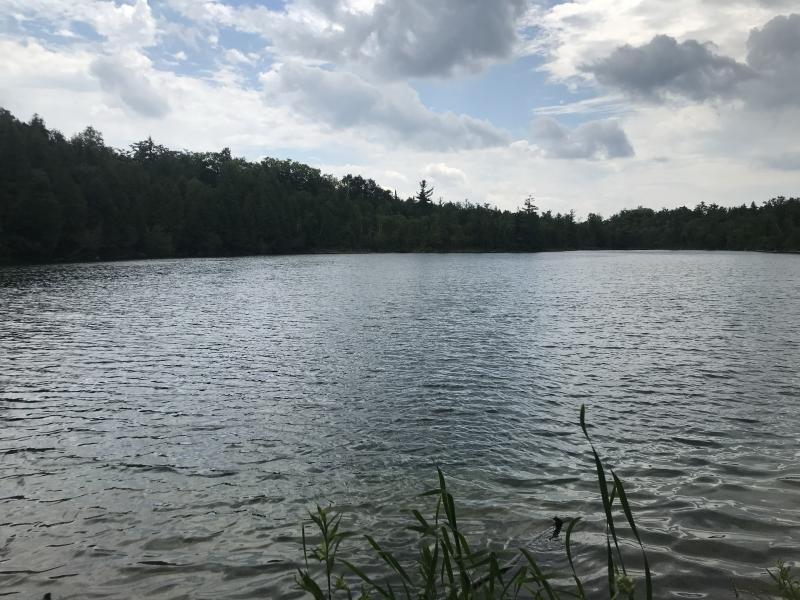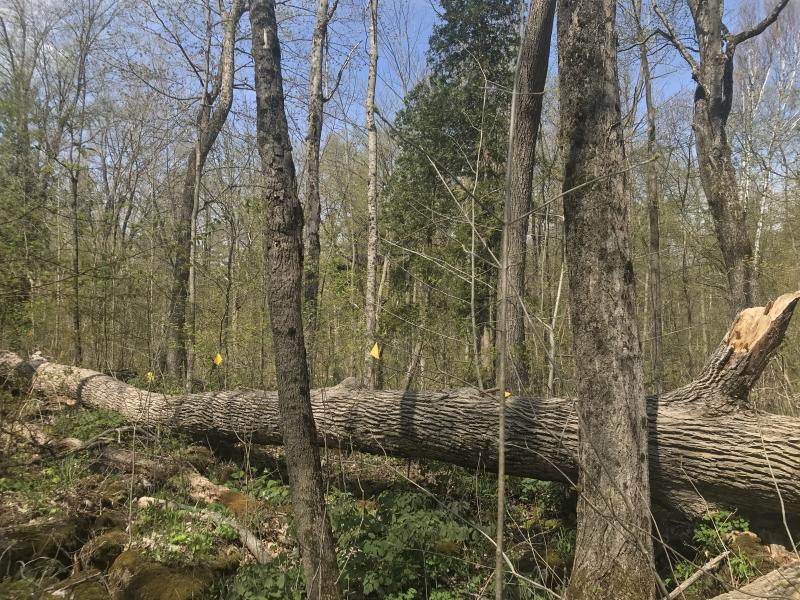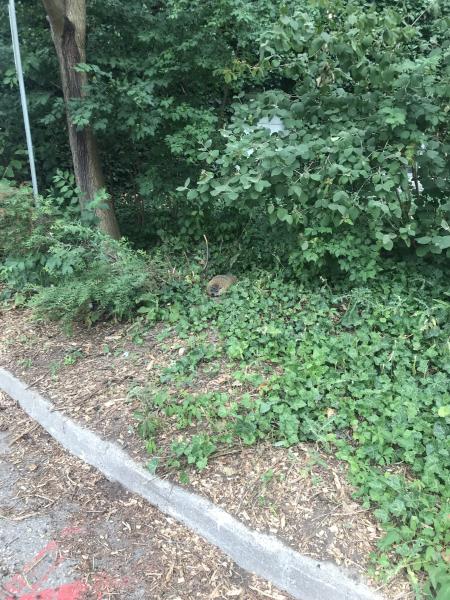Crawford Lake Conservation Area is a 94-hectare protected area that is managed by Conservation Halton. Sitting on top of the Niagara Escarpment, the conservation area is centered around Crawford Lake, which is a rare meromictic lake (a lake that does not mix) formed during the last glacial period. The park features a reconstruction of a 15th century Iroquoian longhouse with accompanying exhibitions on Indigenous lifeways and agricultural innovations, including a Three Sisters garden. In addition, a series of trails runs through forests and along the escarpment edge, including a boardwalk that loops around the lake.
The most common ecosystem types of Crawford Lake Conservation Area are rich hardwood forests dominated by sugar maple, ironwood, ash, and red oak, and interspersed with blue beech/musclewood, black cherry, basswood, hickories, and white pine. Red elder, eastern leatherwood, mountain maple, alternate dogwood, gooseberries, and raspberries are common in the shrub understory. The forest floor is rich in wildflowers, such as trout lily, running strawberry, hepaticas, Canada mayflower, bloodroot, wild ginger, violets, blue cohosh, and ferns, including bulblet ferns and wood ferns. Cedar and maple forests grow along the escarpment edge, while hemlock and balsam fir forests dominate the escarpment canyons. The western end of the conservation area also has patches of pine plantations and old fields, which are a remnant from logging operations dating to the 1800s.
Iroquoian peoples, whom archaeologists believe to be Huron-Wendat (also spelled Wyandot, Wyandotte, and Huronne) and Attawandaron (Neutrals), lived in a series of villages around Crawford Lake from the early 1400s until the mid-1500s. Iroquoian agricultural practices since they began maize-beans-squash intercropping long ago, was to shift village locations every couple of decades, to allow the soil and woodlands surrounding the clearing to replenish. Several historic village sites have been located within a 5 kilometer radius of Crawford Lake, including a village that sat right beside the lake. This village had 6 longhouses that supported approximately 450 people and was surrounded by a wooden palisade.
The meromictic nature of Crawford Lake is such that it has preserved a record in abundance of detail on the lifeways and activities of the Indigenous peoples that lived in these villages. Most lakes in Ontario are structured in such a way that the lake water forms two major layers. Typically, lakes in the summer will have a deep layer of cold water at the lake bottom, and a warm layer of water at the surface. This temperature pattern reverses in the winter, with warmer water at the lake bottom and colder water at the surface. During the spring and autumn when the stratification patterns reverse, water layers in lakes mix, creating currents that disturb sediments on the lake bottom. However, meromictic lakes do not ever mix. In the case of Crawford Lake, this is because the groundwater that feeds the lake is slightly saline from leaching of calcium carbonate from the surrounding limestone bedrock formation, which makes the water on the bottom of the lake heavier. Lakes receive inputs of material from the surrounding environment, including plant and animal remains, dust and other atmospheric debris. Because Crawford Lake does not mix, the sediment layers that are deposited into the lake every year are not disturbed, and therefore have become a well-preserved, layered record of what the surrounding environment was like in each year.
Changes in pollen composition in Crawford Lake’s sediments around 1500 CE suggest that the forests around the lake shifted from maple-beech dominant to oak and pine dominant. The increase in charcoal in lake sediment during this time, in concert with records of Indigenous habitation of the area, suggests that these forest changes were driven by Indigenous cultural burning. Furthermore, an increase in the pollen of maize and other grasses, as well as purslane, Indian Chickweed, and sunflower seeds, which were all important elements of Indigenous agriculture, show that the people living in Crawford Lake practiced agriculture as part of their food systems.
More recent environmental changes associated with European settlement and industrialization are also documented in the lake sediment. Sediment layers dating to the 1800s are rich in algal species, demonstrating a record of algal blooms that occurred due to increases in nutrients running into the lake from the operation of a nearby sawmill. Sediment layers from the 1800s to 1950s saw the increase in fly ash deposits, which were produced from coal combustion. Fly ash concentrations only dropped post 1970s, correlating with the introduction of emissions controls and other environmental regulations. Finally, an increase in radioactive cesium and plutonium was recorded during the 1950s to 60s, which corresponded to a period of nuclear weapons testing.
On July 11, 2023, a group of scientists called the Anthropocene Working Group designated Crawford Lake as the site of the Golden Spike of the Anthropocene. The Golden spike is a geological marker of the transition from one geologic epoch to another. Due to the detailed environmental records that are preserved in the sediments of Crawford Lake, this site provides the best documentation of the rapidly increasing influence of human activity on the environment that marks the transition from the Holocene to the Anthropocene epoch.
Conservation Halton, Crawford Lake Conservation area: https://www.conservationhalton.ca/parks/crawford-lake/
“Canada’s Crawford Lake Selected as Top World Site to Define Start of Proposed Anthropocene Epoch,” found online at: Canada’s Crawford Lake Selected as Top World Site to Define Start of Proposed Anthropocene Epoch | Royal Ontario Museum (rom.on.ca)
Johnson, Lorraine. 2007. The Natural Treasures of Carolinian Canada: Discovering the Rich Natural Diversity of Ontario’s Southwestern Heartland. Carolinian Canada Coalition.
Kelly, Peter E. and Larson, Doug. 2007. The Last Stand: A Journey Through the Ancient Cliff-face Forest of the Niagara Escarpment. Natural Heritage Books.
Mt.Pleasant, Jane. 2006. “The Science Behind the Three Sisters Mound System: An Agronomic Assessment of an Indigenous Agricultural System in the Northeast.” In Histories of Maize, edited J. E. Staller, R. H. Tykot, and B. F. Benz, pp. 529–537. Academic Press, Amsterdam, The Netherlands.
Mt.Pleasant, Jane. 2015. “A New Paradigm for Pre-Columbian Agriculture in North America.” In Early American Studies: An Interdisciplinary Journal 13:374–412. DOI:10.1353/eam.2015.0016.
| English | Latin | Kanienʼkéha | Anishinaabemowin |
|---|---|---|---|
| Wild Ginger | Asarum canadense | tsyonehskwénrye | namepin, nmepin |
| Yellow Birch | Betula alleghaniensis | tsyotsyó:ren | wiinizik (-oog, plural) |
| Bitternut Hickory | Carya cordiformis | o’nón:na, ontsí:kahwe, yohso'kwatskà:rat | mitigwaabaak (-ook, plural) |
| Black Ash | Fraxinus nigra | éhsa | baapaagimaak, bwoyaak |
| Green Ash | Fraxinus pennsylvanica | kaneróhon | emikwaansaak, aagimaak, bwoyaak |
| Red Maple | Acer rubrum | ka’takén:ra | zhiigmewanzh, zhiishiigimiiwanzh (-iik, plural) |
| Sugar Maple | Acer saccharum | wáhta’, ohwáhta | ininaatik, ininaatig (-oog, plural) |
| White Baneberry | Actaea pachypoda | onekwénhtara niwahyò:ten, orá:tu | wiikizigan, wapkadak |
| White Snakeroot | Ageratina altissima | teyohontáthe | bi'jikiw'ack |
| Wild Sarsaparilla | Aralia nudicaulis | tsyotere'se'kó:wa, yonekó:wa, tsyawenséhsha, otsyawénhsa | waaboos-odji-bik, waabooz jiibik |
| Jack-in-the-pulpit | Arisaema triphyllum | tyehnónhserote, kyehnónserote, kárhon, tsyorákares, tsorákares, kahnéhserote, okwá:rot nikarhonksherá:'a | zhaashaagomin |
| Wild Ginger | Asarum canadense | tsyonehskwénrye | namepin, nmepin |
| Yellow Birch | Betula alleghaniensis | tsyotsyó:ren | wiinizik (-oog, plural) |
| Musclewood | Carpinus caroliniana | yotenakaratí:wen | Ska’ agon-mins, Shka agonmins |
| Bitternut Hickory | Carya cordiformis | o’nón:na, ontsí:kahwe, yohso'kwatskà:rat | mitigwaabaak (-ook, plural) |
| Blue Cohosh | Caulophyllum thalictroides | karhakón:ha, kahrhatakon | kwemshkiki, be'cigodji'bigak, bezhigojiibik, zhiigimewibag |
| Alternate-leaf Dogwood | Cornus alternifolia | teyotsí:tsayen | moozwemizh, moozomizh, niibiishan miskwaabiimizhiig |
| Round-leaf Dogwood | Cornus rugosa | (check this) | mazh’omizh |
| Trout Lily | Erythronium americanum | skatsihstóhkonte | namegbagoniin |
| Running Strawberry-bush | Euonymus obovatus | (check this) | (check this) |
| Black Ash | Fraxinus nigra | éhsa | baapaagimaak, bwoyaak |
| Green Ash | Fraxinus pennsylvanica | kaneróhon | emikwaansaak, aagimaak, bwoyaak |
| Sharp-lobed Hepatica | Hepatica acutiloba | kontirontá:non, karón:tanonhne | gabisan’ikeag, a'nima'sid |
| Spotted Jewelweed | Impatiens capensis | ietsi'erorókhstha, yetsi'erorókhstha | gzhiibosegaateaa, makikiibag, wesa’wasga’skonek, ozaawashkojiibik |
| False Solomon’s Seal | Maianthemum racemosum | kítkit o'éta | agongseminan, agongosimizh, agong’osiminan |
| Starry Solomon’s Seal | Maianthemum stellatum | kítkit o'éta | agongseminan, agongosimizh, agong’osiminan |
| Ironwood | Ostrya virginiana | tysoráhsa | maananohns, maananoons (-ak, plural) |
| Virginia Creeper | Parthenocissus quinquefolia | kontiráthens | mnidoo- biimaakwad bebaamooded |
| White Pine | Pinus strobus | tyonerahtase'kó:wa, onehta'kó:wa, ohnehta’kó:wah | biisaandago-zhingwaak, zhingwaak, shingwaak |
| Downy Solomon’s seal | Polygonatum pubescens | kítkit o'éta | agongseminan, agong’osiminan |
| Black Cherry | Prunus serotina | é:ri, e:ri’kó:wa, tyotyò:ren | ookweminagaawanzh, ookweminan, ikwe'mic |
| Chokecherry | Prunus virginiana | tyakonya’tawén:’eks, teyakonya’tawén:’eks | asasaweminagaawanzh, asasaweminan, baakinminaan, asasaweminogaawangh |
| Red Oak | Quercus rubra | karíhton | miskode-miizhmizh, mitig mewish (-iik plural) |
| Prickly Gooseberry | Ribes cynosbati | tyorenatsí:yo, ohrá:ton, anáduma:o:náhi | zhaabo-miinashkoon, zhaaboomin (-aak, plural), me’skwacabo’minak, kaawe-saba, Zhaaboominagaawanzh/iig "going through/piercing berr plant/s or shrub/s" |
| Swamp Gooseberry | Ribes hirtellum | tyorenatsí:yo, ohrá:ton, anáduma:o:náhi | zhaabo-miinashkoon, zhaaboomin (-aak, plural), me’skwacabo’minak, kaawe-saba |
| Black Swamp Gooseberry | Ribes lacustre | tyorenatsí:yo, ohrá:ton, anáduma:o:náhi | zhaabo-miinashkoon, zhaaboomin (-aak, plural), me’skwacabo’minak, kaawe-saba |
| Red Raspberry | Rubus idaeus | skanekwen’terá:yen, skanekwen’terá:ne, skanekwenhtará:nenh | miskomin (-ak, plural) |
| Purple Flowering Raspberry | Rubus odoratus | ahtahkwakáyu, ahtahkwaká:yon | miskomin (-ak, plural) |
| Red Elderberry | Sambucus racemosa | ahrhakéha | papashkisiganak (-oon, plural) |
| Bloodroot | Sanguinaria canadensis | tekanekwas, tekané:kwaks, tekanekwénhshya'ks | miskwi- chiibikoon |
| Zig-zag Goldenrod | Solidago flexicaulis | otsí:nekwar niyotsi’tsyò:ten | ajidamoowaanow, waabanoominens/waabanoominensag, giizisso mashkiaki |
| Dandelion | Taraxacum officinale | tekaronhyaká:nere | mindemoyanag, doodooshaaboojiibik, mindimooyenh, wezaawaaskwaneg |
| Early Meadow Rue | Thalictrum dioicum | otsi’tsyakérha | (check this) |
| Basswood | Tilia americana | ohóhsera | wiigobiish, wiigob, wiigobiig (plural) |
| White Trillium | Trillium grandiflorum | tsyonatsyakén:ra niyotsi’tsyò:ten, tsyoná:tsik, áhsen niioneráhtonte | ininiiwindibiigegan, baashkindjibgwaan, baushkindjibgwaun, ini'niwin'digige'gun |
| Slippery Elm | Ulmus rubra | akará:tsi | ozhaashigob |
| Maple-leaf Viburnum | Viburnum acerifolium | karhata’kéha | miinan |
| White Violet | Viola canadensis | tekonnyarotárhoks, tekonteniarotáhrhoks, tewatenyarotárhos | maskwi’widzhi’wiko’kok |
| Long-spur Violet | Viola rostrata | tekonnyarotárhoks, tekonteniarotáhrhoks, tewatenyarotárhos | we-waawiyeyaa-bagak, wewaie’bagag |
| Wild Grape | Vitis riparia | o’nénhare | zhoominan, jo’minaga’wanj |



